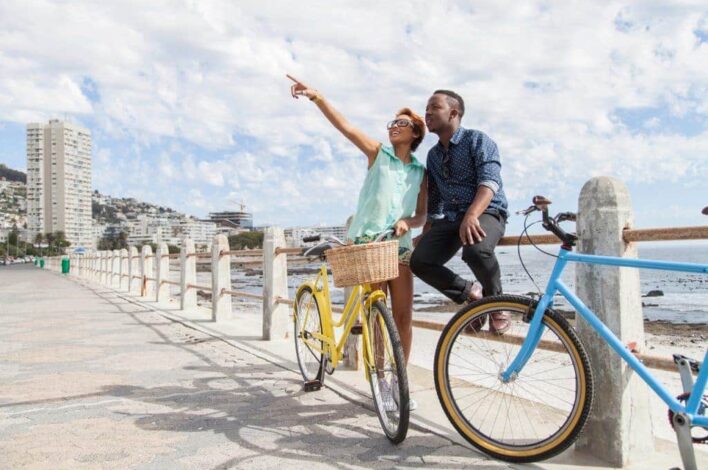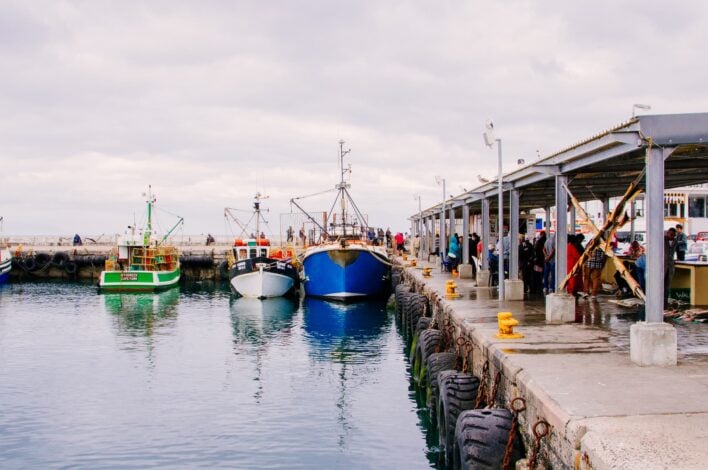
Cape Town’s City Bowl is its lifeblood. This is where the action is, from museums and art galleries to bars and restaurants. Cape Town is also quite unique in that there are spectacular beaches, forests, and mountains surrounding the inner city itself, so you’re never too far from somewhere amazing. Start at the V&A Waterfront, which is basically a neighbourhood in its own right. You can grab some breakfast at any of the incredible restaurants and cafes here, but don’t get too distracted—there’ll be time to check the Waterfront out properly later. For now, head for the City Sightseeing bus stop.
There is genuinely no better way to see Cape Town than by enjoying the scenery from the top level of the open-top bus. Pro-tip: it’s also worth getting your hands on a Cape Town City Pass, which will get you free entry to over 70 attractions, many of which are on the route. We’d recommend taking the Red route, which takes about an hour and a half if you just sit back and enjoy the ride. Allow most of the day for it though, because you’ll want to stop off at some of the amazing attractions en route! Start with Table Mountain, where you can take the cable car to the top and take advantage of the 360º views to survey the incredible city you’re about to explore. From here, the bus takes you over the mountain to the Altantic Seaboard, where you’ll be able to visit the gorgeous sandy beaches of Camps Bay and Clifton. If the weather is good, hop off at Sea Point and take a stroll (or rent a bike and cycle) along the Sea Point Promenade to the next stop.
When you arrive back at the Waterfront, spend a few hours here. Do some shopping, take a spin on the Cape Wheel, or marvel at the diversity of our marine life at the Two Oceans Aquarium. As sunset approaches, head to one of the incredible bars overlooking the ocean, and order a bottle of local wine to enjoy with the views. Your dinner options are endless, too. There are hundreds of choices at the Waterfront or in the city, ranging from fine dining to casual burgers or pizzas. Once you’re well fed, head to the City Bowl (and Long Street in particular) for live music, cocktails, dancing, or a night cap. If you’re ahead of schedule, there’s also some amazing shopping to be done here by day. Sit at a pavement table to people watch, but remember to hold onto your valuables, or keep them out of sight.

On Day 2, explore the other side of Cape Town, starting with a scenic drive along Victoria Road and over Chapman's Peak. This will take you to Hout Bay, where you can enjoy the beach and stunning scenery. If time allows, consider a trip to Cape Point, known for its breathtaking cliffs and endless views.
Continue to False Bay and visit Simon's Town, home to Boulders Beach, where you can get close to the African Penguin colony and relax on the sheltered swimming beach. Next, head to Kalk Bay, known for its quirky curio vendors, antique shops, and boutiques. It's also a great place for seafood, with options like Harbour House and Kalky's. The colorful fishing boats and bustling harbor make for fantastic photographs, and you can watch Cape fur seals and fishermen in action.
As you make your way back towards town, consider a stop in Kirstenbosch, the first botanical garden in the world to be established (in 1913) to protect local flora. Its lawns are ideal for picnics and there are several walking trails. You can spend the rest of the afternoon here, and maybe even stop off for a quick wine-tasting in Constantia if it’s before 4 pm. Constantia is also home to some of the country’s best fine-dining restaurants, if that’ your cup of tea. Just make sure you book long in advance. Otherwise, take a look at our neighbourhood guides to find a good restaurant close to where you’re staying.
Cape Town Tourism is the Official Destination Marketing Organisation for the City of Cape Town.


Cape Town Tourism
We firmly believe that the internet should be available and accessible to anyone, and are committed to providing a website that is accessible to the widest possible audience, regardless of circumstance and ability.
To fulfill this, we aim to adhere as strictly as possible to the World Wide Web Consortium’s (W3C) Web Content Accessibility Guidelines 2.1 (WCAG 2.1) at the AA level. These guidelines explain how to make web content accessible to people with a wide array of disabilities. Complying with those guidelines helps us ensure that the website is accessible to all people: blind people, people with motor impairments, visual impairment, cognitive disabilities, and more.
This website utilizes various technologies that are meant to make it as accessible as possible at all times. We utilize an accessibility interface that allows persons with specific disabilities to adjust the website’s UI (user interface) and design it to their personal needs.
Additionally, the website utilizes an AI-based application that runs in the background and optimizes its accessibility level constantly. This application remediates the website’s HTML, adapts Its functionality and behavior for screen-readers used by the blind users, and for keyboard functions used by individuals with motor impairments.
If you’ve found a malfunction or have ideas for improvement, we’ll be happy to hear from you. You can reach out to the website’s operators by using the following email
Our website implements the ARIA attributes (Accessible Rich Internet Applications) technique, alongside various different behavioral changes, to ensure blind users visiting with screen-readers are able to read, comprehend, and enjoy the website’s functions. As soon as a user with a screen-reader enters your site, they immediately receive a prompt to enter the Screen-Reader Profile so they can browse and operate your site effectively. Here’s how our website covers some of the most important screen-reader requirements, alongside console screenshots of code examples:
Screen-reader optimization: we run a background process that learns the website’s components from top to bottom, to ensure ongoing compliance even when updating the website. In this process, we provide screen-readers with meaningful data using the ARIA set of attributes. For example, we provide accurate form labels; descriptions for actionable icons (social media icons, search icons, cart icons, etc.); validation guidance for form inputs; element roles such as buttons, menus, modal dialogues (popups), and others. Additionally, the background process scans all the website’s images and provides an accurate and meaningful image-object-recognition-based description as an ALT (alternate text) tag for images that are not described. It will also extract texts that are embedded within the image, using an OCR (optical character recognition) technology. To turn on screen-reader adjustments at any time, users need only to press the Alt+1 keyboard combination. Screen-reader users also get automatic announcements to turn the Screen-reader mode on as soon as they enter the website.
These adjustments are compatible with all popular screen readers, including JAWS and NVDA.
Keyboard navigation optimization: The background process also adjusts the website’s HTML, and adds various behaviors using JavaScript code to make the website operable by the keyboard. This includes the ability to navigate the website using the Tab and Shift+Tab keys, operate dropdowns with the arrow keys, close them with Esc, trigger buttons and links using the Enter key, navigate between radio and checkbox elements using the arrow keys, and fill them in with the Spacebar or Enter key.Additionally, keyboard users will find quick-navigation and content-skip menus, available at any time by clicking Alt+1, or as the first elements of the site while navigating with the keyboard. The background process also handles triggered popups by moving the keyboard focus towards them as soon as they appear, and not allow the focus drift outside it.
Users can also use shortcuts such as “M” (menus), “H” (headings), “F” (forms), “B” (buttons), and “G” (graphics) to jump to specific elements.
We aim to support the widest array of browsers and assistive technologies as possible, so our users can choose the best fitting tools for them, with as few limitations as possible. Therefore, we have worked very hard to be able to support all major systems that comprise over 95% of the user market share including Google Chrome, Mozilla Firefox, Apple Safari, Opera and Microsoft Edge, JAWS and NVDA (screen readers).
Despite our very best efforts to allow anybody to adjust the website to their needs. There may still be pages or sections that are not fully accessible, are in the process of becoming accessible, or are lacking an adequate technological solution to make them accessible. Still, we are continually improving our accessibility, adding, updating and improving its options and features, and developing and adopting new technologies. All this is meant to reach the optimal level of accessibility, following technological advancements. For any assistance, please reach out to